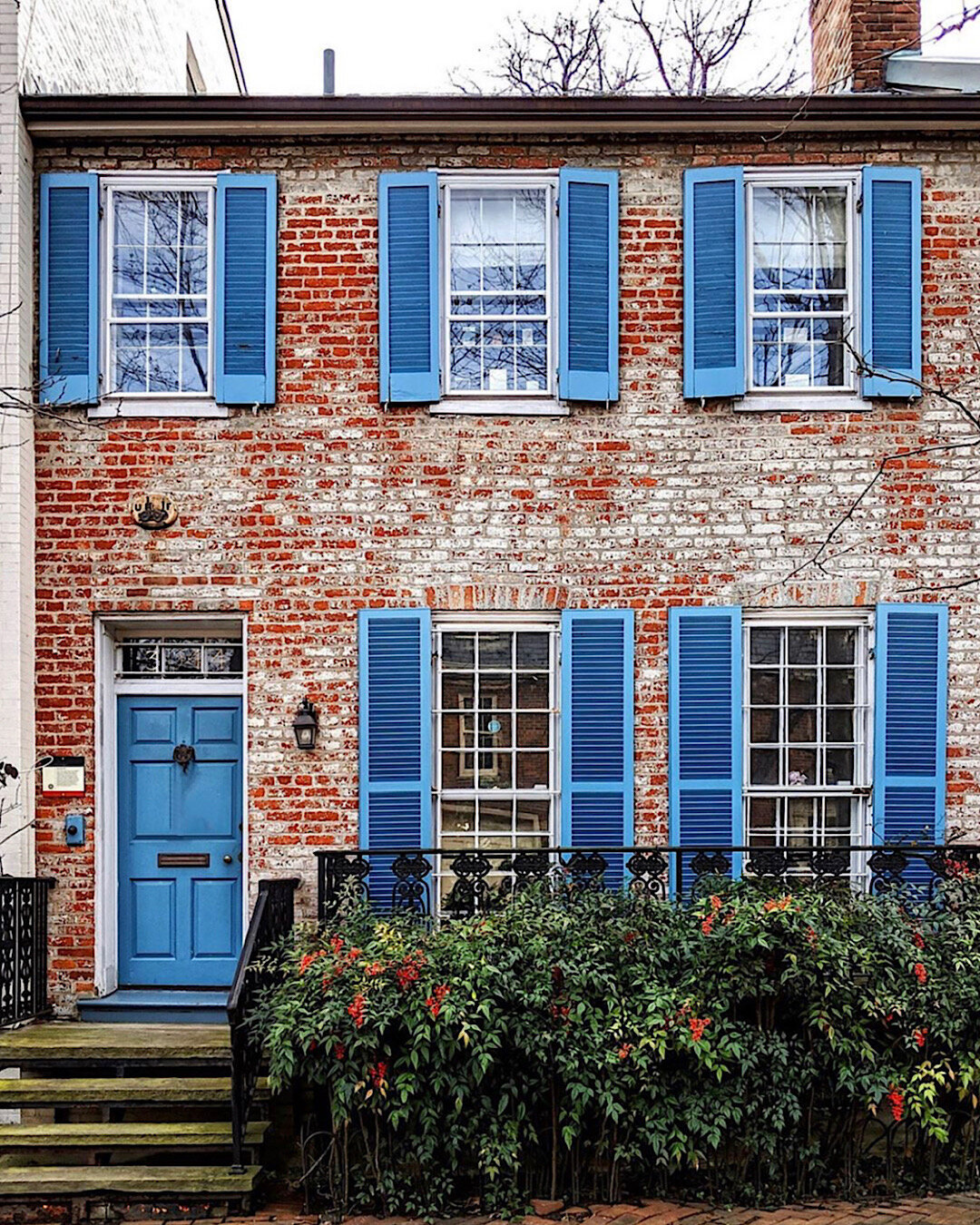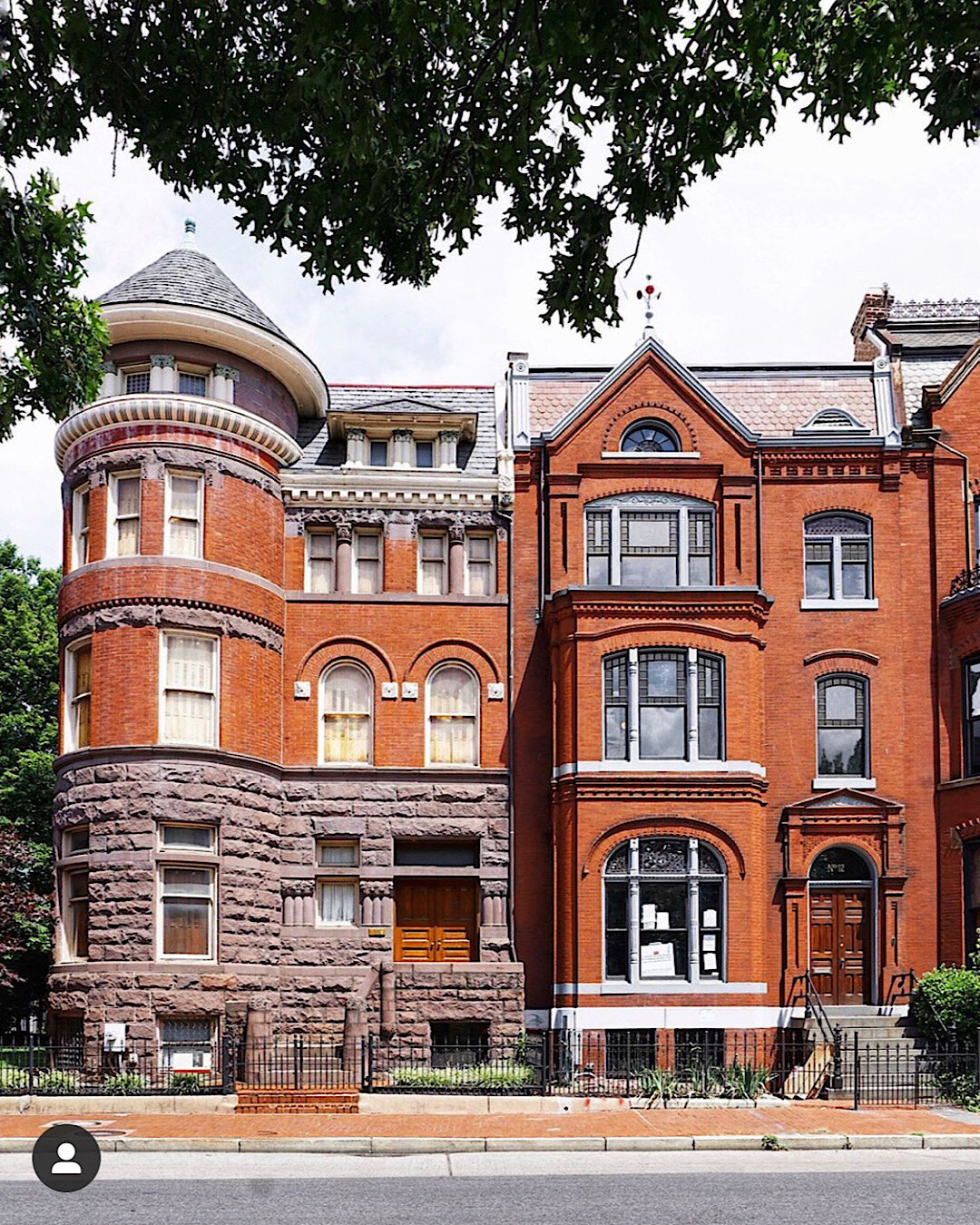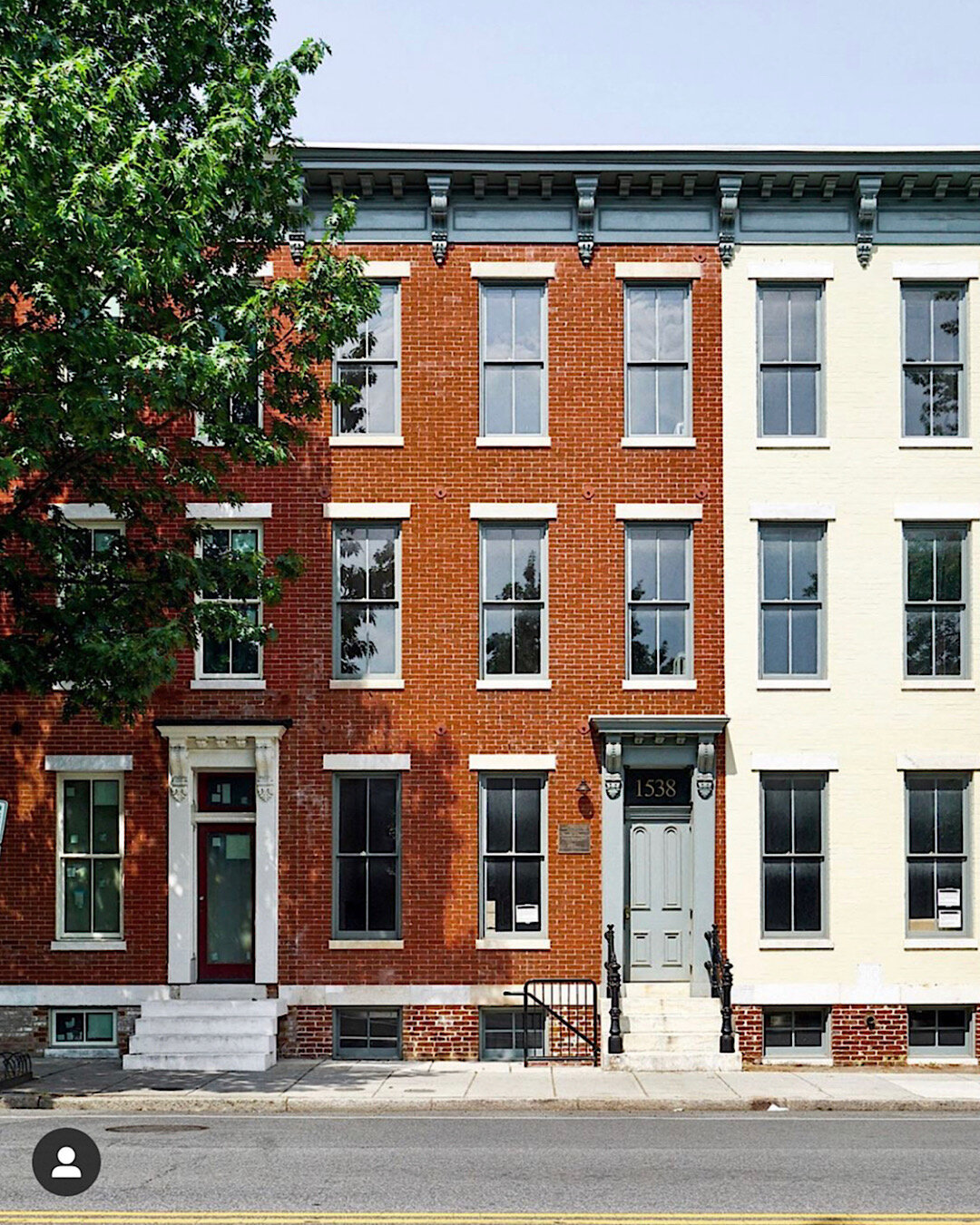historic black homes and businesses
2900 O Street, NW
Feature 1
This was the home of Alfred Pope (1821-1906) and Hannah Cole Pope (1828-1910), a prominent Georgetown couple, active in public affairs and real estate.
Hannah was born in the home of Thomas Peter and Martha Custis Peter (now Tudor Place), where she and her mother were enslaved. In 1845 Hannah was sold to South Carolina Congressman John Carter, in whose household she met Alfred Pope. The two married in 1847. The two were freed upon Carter’s death in 1850. They remained in Georgetown, where Alfred parlayed savings from a job as the town collector into businesses in real estate. Alfred represented Georgetown before Congress in 1870 during the debate over merging Georgetown with Washington City. He also served as a trustee of the public DC Colored Schools.
620 T Street, NW
Feature 2
The Howard Theatre opened in 1910 and served as a showcase for African American artists for more than 70 years. Billed as the "Theater for the People," its live music, plays, vaudeville, movies, and talent contests drew audiences and performers from the city and throughout the United States. It was also home of two theatrical troupes: the Lafayette Players and the Howard University Players. The theater had a seating capacity of more than 1,200 in three levels: orchestra, balcony, and eight proscenium boxes.
Along with Duke Ellington, greats such as Ella Fitzgerald, Louis Armstrong, Billie Holliday, Cab Calloway and Nat King Cole graced the Howard stage and made way for talents like Marvin Gaye, Aretha Franklin, Dizzy Gilespie, The Supremes, Otis Redding, Lena Horne and James Brown.
Source: Cultural Tourism DC/TheHowardTheatre.com
1256 Kearny Street NE
Feature 3
On Aprill 30, 2020, the Slowe-Burrill House became DC's newest historic landmark. This house was once home to two of the most influential and distinguished educators in Washington, DC: Lucy Diggs Slowe and Mary Burrill. Slowe and Burrill were life partners for over 20 years.
Their relationship endured an era of societal prejudice and non-acceptance towards the LGBTQ community. Now designated, the house will join the Dr. Franklin E. Kameny House and Furies Collective in the DC Inventory of Historic Sites for its association with DC's LGBTQ history. A couple highlights of Slowe's career include being tasked by the District to create the first public junior high school for African Americans and becoming the first Dean of Women at Howard University in 1922.
Her partner, Mary Burrill, was a dedicated educator throughout her life. She taught at a number of DC schools, with her longest tenure at Dunbar High. She was also a well-known and influential playright.
Source: DC Preservation League
Feature 4
The Mary McLeod Bethune Council House National Historic Site, formerly the occasional home of educator and civil rights leader Mary McLeod Bethune (1875–1955), was the first headquarters of the National Council of Negro Women. Bethune founded NCNW in 1935 and served as its first president. Among her most influential federal appointments during the New Deal era was the directorship of Negro Affairs for the National Youth Administration from 1936 to 1943. In all she served as advisor to four U.S. presidents. The three-story Victorian main house is a house museum with permanent and changing exhibits interpreting the life of Bethune and black women’s history operated by the National Park Service.
Source: The National Park Service
Feature 5
Pomander Walk (Formerly Bell Court) After the Civil War, the African American population grew. Usually, they lived in distinct neighborhoods called alleyway slums. The forty or so African American residents who lived in Bell Court, named after Alexander Graham Bell (whose residence was across the street) used the alleyway as a public space where they sang, played cards and tended to chickens and dogs. A pamphlet published in 1912 found 3,337 houses in 275 D.C. alleys. (per @wapo and Georgetown African American Historic Landmark Project & Tour)
Feature 6
This was John H. Fleet’s home, who was an educator, violinist, and abolitionist. Fleet, trained as a physician, chose teaching over practicing medicine and established his first school in 1836. In 1843 the school was burned by white arsonists but he reopened the school three years later. Fleet also participated in the local Underground Railroad movement, organizing “sitting parties” to raise money for individuals and families seeking freedom. He devoted the last ten years of his life to playing and teaching music. He died in 1861, the year of his birth remains unknown. Source: African American Heritage Trail. House: 1208 -30th St NW
Cecil Alley, Georgetown
Once Cissel Alley and now named Cecil Place, took its name from the Cissel family that owned the flour mill at Potomac and Grace at the end of the 19th century. This is how the area described the inhabitants of Georgetown from Cissel Alley over to 31st Street in 1909 as a part reporting on Georgetown’s alley dwellings. “Cecil Alley” or “Cissell Alley” whose ancient cobblestone pavement leads down a steep hill past a row of two-story-and-basement brick rowhouses inhabited by rather needy white families. Back of this row is “Cherry Hill” with its cluster of brick and wooden dwellings occupied by colored people. Further east, on Thirty-second street, Grace Church stands near the end of the unrefined little street which bears its name. Behind the church is “Brickyard Hill” where both white and Black people have lived for many years in a remarkable collection of unsanitary houses.
Black Georgetown Remembered reported that by 1910, most of the neighborhood had become predominantly African American, as whites abandoned Georgetown’s narrow, crowded streets for better housing and employment elsewhere in the city.
Source: Georgetown African American Historic Landmark Project & Tour
633 Pennsylvania Ave, NW
The National Council of Negro Women, founded by Mary McLeod Bethune in 1935, moved to this grand former hotel building in 1995. Dr Dorothy Height, who led the organization in the later part of the century was awarded the Presidential Medal of Freedom in 1994. She stepped down from the presidency of the NCNW in the late 1990s, but remained the organization's chair of the board until her death in 2010.
It is the only African American organization with property between the Capitol and the White House on historic Pennsylvania Avenue.
Source: NCNW
First Street, NE
In the 1920s and 1930s the National Women's Party was headquartered here, and African American women worked with the party to obtain full voting rights for women. In 1935 the U.S. Supreme Court replaced the old building.
Source: Cultural Tourism DC
1213 U Street, NW
In the early 1900's, U Street was known as Black Broadway with its various theatres and performance halls. This area of DC was still segregated.
Built in 1910, this well known DC restaurant first housed a silent movie house called the Minnehaha Theater. Later, Harry Beckley, one of D.C.’s first Black police detectives, converted it into a pool hall. And in 1958, newlyweds Ben and Virginia Ali purchased and renovated what would become a DC institution. On August 22, 1958, Ben’s Chili Bowl opened for business at 1213 U Street and all were welcome at Ben's!
From the 1968 race riots to the tough times in the 70’s and 80’s and finally to the revitalization of the U Street Corridor beginning in the 90’s, Ben’s has seen and survived it all. After a 61-plus year journey, the Ben’s brand is red hot and is a must-visit restaurant for anyone visiting Washington.
Source: Ben's Chili Bowl
3044 P Street NW
Emma V. Brown opened a school for Georgetown’s Black children in her home in 1861. Miss Brown dedicated her life to educating Washington’s Black children and became one of the two teachers at the first publicly financed school for Blacks. This school was organized in the basement of the Ebenezer Methodist Church on Capitol Hill in 1864. Miss Brown later became the head of the John F. Cook School on O Street, NW and the principal of the Sumner School at 17th and M Street, NW.
(Source: National Park Service via Georgetown African American Historic Landmark Project & Tour)
8 Logan Circle, NW
8 Logan Circle (on left) was the home of Belford V. Lawson and Marjorie M. Lawson
Belford V. Lawson (1909-1985) and Marjorie M. Lawson (1912-2002) were a formidable legal couple. Belford served as lead attorney for New Negro Alliance v. Sanitary Grocery (1938), the Supreme Court case that safeguarded a right to boycott. Marjorie, U.S. representative to the United Nations Economic and Social Council, served as a DC Juvenile Court judge.
The Lawsons lived at this address from 1938 until 1958, at times sharing their home with Congressman Adam Clayton Powell, Jr. (D.-NY), who rented the third floor during his tenure in Congress.
Belford met Marjorie at the Robert H. Terrell Law School, where he was a teacher and she was a law student. Marjorie received a B.A. and M.A. from the University of Michigan before coming to the Terrell Law School in Washington. She also earned a degree in 1950 from Columbia Law School and served as general counsel for the National Council of Negro Women, and as an adviser to John F. Kennedy's 1960 presidential campaign. When she was appointed to the Juvenile Court bench by President Kennedy in 1962, she was the first black woman to serve on a local court in Washington.
Source: Cultural Tourism DC: Logan Circle African American Heritage Trail
1421 S Street, NW
Across the street from the house I posted yesterday, with all the beautiful hydrangeas, is this house at 1421 S Street Northwest.
Georgia Douglas Johnson (1877-1966) was born in Atlanta, Georgia. After graduating from Oberlin Conservatory in 1903, she and her husband Henry Lincoln Johnson moved to Washington, DC in 1910. It was here that Johnson's writing career flourished, making her a nationally recognized figure of the New Negro Renaissance. Johnson wrote poetry, songs, short stories, plays, and a syndicated newspaper column titled "Homely Philosophy." Johnson was not able to live off her earnings as a writer and held a number of jobs, including a stint as a conciliator with the Labor Department from 1925 until 1940. As Commissioner of Conciliation, she was charged with investigating the conditions under which workers lived.
Once the Johnsons moved to Washington, Henry opened a law practice. In 1912. President William Howard Taft appointed him recorder of deeds for the city. He passed away in 1925.
During the 1920's and 30's, their home served as a literary salon on Saturday evenings, welcoming such luminaries as Mary Burrill, Alice Dunbar Nelson, Angelina Grimke, Langston Hughes, Alain Locke, Kelly Miller, and Willis Richardson. Johnson organized an international correspondence club from 1930 to 1965 in which she corresponded with prisoners and invited them to her home after their release.
Source: Cultural Tourism DC
1934 4th Street, NW
Paul Laurence Dunbar, one of the most honored poets from the turn of the last century, lived in Ledroit Park with his wife, Alice, and he was one of the first nationally recognized African-American writers with a play and several volumes of poetry and he received a ceremonial sword from president Teddy Roosevelt.
Dunbar found in Ledroit Park a cohesive and self-sufficient Black community, and he was happy there. He died of tuberculosis at the age of 34.
This house is at 1934 4th St NW where he first lived. He then moved to 321 U St. Northwest when he got married.
Source: Curbed
1439 Swann Street, NW
John Wesley Cromwell lived here at 1439 Swann Street, NW, from 1894 until his death in 1927.
A lawyer, scholar, and publisher, John Wesley Cromwell (1846-1927) was a prolific writer, Cromwell wrote, The First Negro Churches in the District of Columbia (1917), The Negro in American History (1914), and other works, and was founder and editor of the People's Advocate, a weekly newspaper published in Alexandria, Virginia, from 1876 until 1886.
Source: African American Heritage Trail Dupont Circle & Strivers' Section
1026 U Street, NW
Lee's Flower Shop originally opened its doors for the first time back in 1945, and has since become the most beloved flower shop in Washington, DC. William and Winnifred Lee actually received their initial loan for Lee's Flower Shop from Industrial Bank, the first Black-Owned bank in Washington DC. With the success with Lee's Flower shop, they began to partner with other successful Black business owners to invest in new Black entrepreneurs and allow them to become established, grow, and thrive along Black Broadway.
This highlights the power that buying Black has in the success of Black communities here and around the country. Lee's is still family owned and operated. After over 70 years of delivering countless smiles, Lee's Flower Shop has become the go-to florist in Washington, DC. Lee's is located at 1026 U Street NW, around the corner from the African American Civil War Museum.
11 Logan Circle, NW
11 Logan Circle (on left) was the home of Charles Manuel "Sweet Daddy" Grace.
Charles M. "Sweet Daddy" Grace (ca. 1882-1960) incorporated the United House of Prayer for All People, Church on the Rock of the Apostolic Faith, in 1927 with national headquarters in Washington at 1117 Seventh Street, NW. Grace, originally from the Cape Verde Islands, was one of several Washington religious leaders offering worshipers an alternative to traditional Christianity. He built his first chapel in 1926 in West Wareham, Massachusetts and moved to Washington in 1929.
Grace was a charismatic leader who amassed a great fortune. He was known for his flamboyant personal style, evidenced by his green and purple coats and long fingernails painted red, white, and blue, which also matched the trim on his house. He became famous for staging huge revivals, faith healings, and mass baptisms. With his large constituency, he and his successors became important players on the city's political stage.
Grace created a legacy assisting the church's poor and working-class members, building day care centers, food banks, senior citizen centers, and well-maintained, inexpensive housing.
Source: Cultural Tourism DC: Logan Circle African American Heritage Trail
1538 Ninth Street, NW
Carter G. Woodson Residence 1538 Ninth Street, NW Carter G. Woodson (1875–1950) devoted his life to the study and promotion of African American history. Here Woodson founded the Association for the Study of Negro Life and History in 1915, the Journal of Negro History in 1916, the Associated Publishers in 1921, and the Negro History Bulletin in 1937.
Woodson, along with Omega Psi Phi Fraternity, launched Negro History Week (now Black History Month) in 1926. He taught at M Street High School and served as a Howard University dean.
A prolific writer with a Ph.D. in history from Harvard University (1912), Woodson influenced generations of scholars, activists, and artists.
1708 S Street, NW
Kappa Alpha Psi fraternity, located at 1708 S Street, NW, was founded at Indiana University in 1911. The ten founders determined from the start that membership would be based solely on achievement. In 1949 the fraternity's Washington Alumni Chapter worked with undergraduate chapters at Howard University and Miner Teachers College to purchase this Georgian style former residence designed by Washington architect Leon E. Dessez. "Kappa Kastle" became a popular center of social activity, activism, and philanthropy for African Americans, especially during the era of racial segregation.
.
Members of the Washington Alumni Chapter have led the way in politics, civil rights, education, medicine, the arts, and other fields.
.
It is worth noting that Washingtonian Leon E. Dessez, FAIA (1858-1918) designed the Admiral's Residence at One Observatory Circle (today the Vice President's House), the Miner Teachers College building on Georgia Avenue, the Gallagher Hospital, and the hospital at the Soldiers Home
.
Source: Cultural Tourism DC, African American Heritage Trail


















